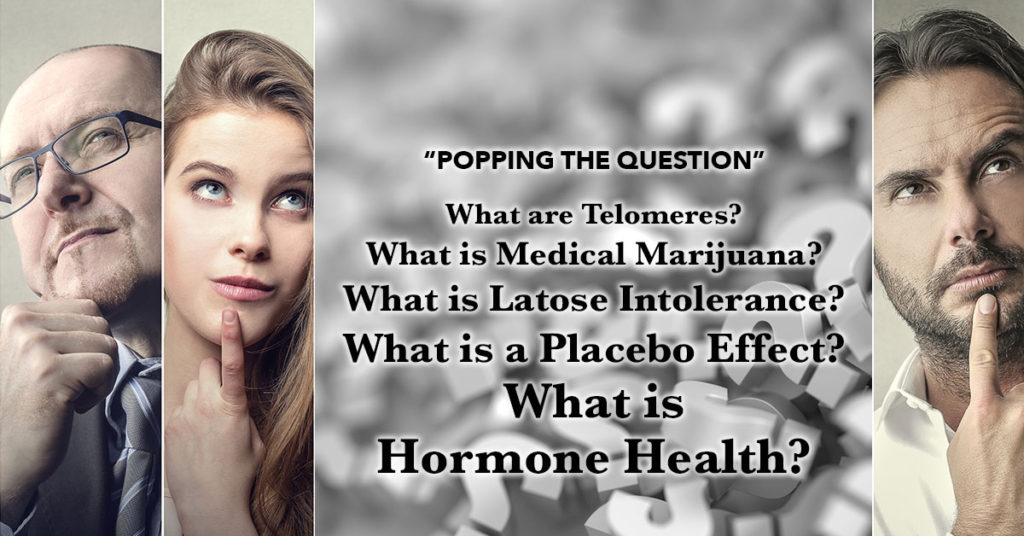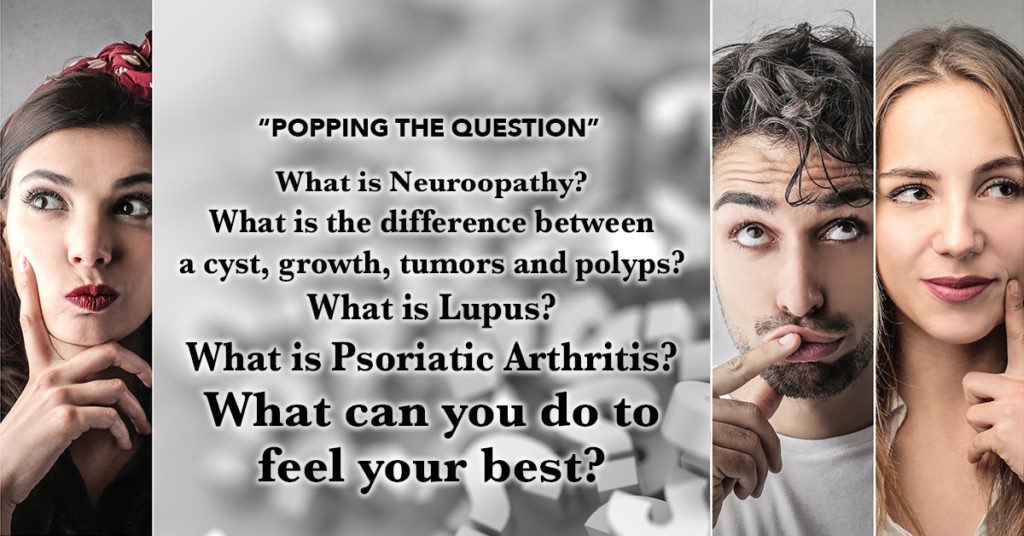
Questions, questions, questions. (Yep, we’re sure by this time you have a ton more of them) To tell the truth, the questions we have about our bodies could fill a book a million times the size of War and Peace. Questions like What is Hormone Health? If you’re still a bit curious, read on.
WHAT ARE TELOMERES?
“I admit I am totally clueless here.”
TO TELL IT
The whole concept of telomeres is best understood once you get an overall view of
DNA, chromosomes and genes. They are all intertwined and work together to keep you alive and make you who you are. It’s kind of complicated, but hopefully we’ll make it clear for you.
ELEPHANTS MAKE ELEPHANTS
We all know that elephants only give birth to little elephants, giraffes to giraffes, dogs to dogs and so on for every type of living creature. But why is this so?
The answer lies in a molecule DNA. DNA contains the instructions needed for an organism to develop, survive and reproduce. To carry out these functions, DNA sequences must be converted into messages that can be used to produce proteins, which are the complex molecules that do most of the work in our bodies. DNA is also what makes each species unique as the biological instructions they make is passed from adult organisms to their offspring during reproduction.
DNA is found inside a special area of the cell called the nucleus. Because the cell is very small, and because organisms have many DNA molecules per cell, each DNA molecule must be tightly packaged into thread-like structures. This packaged form of the DNA is called a chromosome. Chromosomes carry hereditary information for everything from height to eye color. They are made of protein and one molecule of DNA, which contains an organism’s genetic instructions, passed down as we’ve said, from parents. In humans, animals, and plants, most chromosomes are arranged in pairs within the nucleus of a cell.
GENE SCENE
Each DNA sequence that contains instructions to make a protein is known as a gene.
Scientist use the term “double helix” to describe DNA’s winding, two-stranded chemical structure. (If you’re watching this season’s show “Zoo”, they talk about a triple helix. (Remember this is television fantasy, so don’t worry you have one.) The double helix – which looks much like a twisted ladder – gives DNA the power to pass along biological instructions with great precision.
Genes play an important role in determining physical traits — how we look —and lots of other stuff about us. They carry information that makes you who you are and what you look like: curly or straight hair, long or short legs, even how you might smile or laugh. Many of these things are passed from one generation to the next in a family by genes.
Each cell in the human body contains about 25,000 to 35,000 genes. Genes aren’t just found in humans — all animals and plants have genes, too.
To put it in simple terms, the whole DNA/chromosome/gene thing is sort of like recipes in a Cookbook for Life. Fortunately, they do all the cooking.
THE LONG AND SHORT OF IT
At the ends of the chromosomes are stretches of DNA called telomeres, which protect our genetic data, make it possible for cells to divide. Telomeres have been compared with the plastic tips on shoelaces, because they keep chromosome ends from fraying and sticking to each other, which would destroy or scramble an organism’s genetic information. Without telomeres, the ends of chromosomes would look like broken DNA, and the cell would try to fix something that wasn’t broken. Each time a cell divides, the telomeres get shorter. When they get too short, the cell can no longer divide; it becomes inactive or it dies. This shortening process is associated with aging, cancer, and a higher risk of death. So telomeres have also been compared with a bomb fuse. Telomeres can also be shortened by stress, smoking, obesity, lack of exercise and a bad diet. In every way, shortened telomeres can shorten your life.
WHAT IS MEDICAL MARIJUANA?
“Yeah, man…”
SMOKE THIS
Weed, grass, doobie, pot, spliff, bud, Mary Jane…there are more names for marijuana than you can imagine. Marijuana was introduced to American society in 1910 by Mexican immigrants. “Horrors! Immoral!” The backlash was immediate. And then the 60’s slowly and liberally glided into their counterculture heyday and pot was king. And today, its popularity is enjoying an all-time high. Marijuana is greenish-gray mixture of the dried, shredded leaves and flowers of Cannabis sativa—the hemp plant. Some users smoke marijuana in hand-rolled cigarettes called joints; many use pipes, water pipes (sometimes called bongs), or marijuana cigars called blunts (often made by slicing open cigars and replacing some or all of the tobacco with marijuana). Marijuana can also be used to brew tea and, particularly when it is sold or consumed for medicinal purposes, is frequently mixed into foods such as brownies, cookies, or candies. “Yummmmmmmmmmmm….”, more please.
GRADE SCHOOL GANJA
Big problem. Kids are crazy for it. In 2015, 11.8 percent of 8th-graders reported marijuana use in the past year and 6.5 percent were current users. Among 10th-graders, 25.4 percent had used marijuana in the past year and 14.8 percent were current users. Rates of use among 12th-graders were higher still: 34.9 percent had used marijuana during the year prior to the survey and 21.3 percent were current users; 6.0 percent said they used marijuana daily or near-daily. Research has shown that marijuana’s negative effects on attention, memory, and learning can last for days or weeks after the acute effects of the drug wear off, depending on the user’s history with the drug. Consequently, someone who smokes marijuana daily may be functioning at a reduced intellectual level most or all of the time. It’s not exactly producing future scholars and Nobel recipients.
PROBLEMS ALL OVER THE JOINT
While pleasure is key for most users, there are contrary side effects for others, including bloodshot eyes, depression, dizziness, fast heartbeat, low blood pressure and even hallucinations. The drug can also affect judgment and coordination, which could lead to accidents and injuries. Because marijuana contains some of the same chemicals found in tobacco, there have been concerns that smoking it could harm the lungs. The effects of inhaled marijuana on lung health aren’t clear, but there’s some evidence it might increase the risk for bronchitis and other lung problems.
The National Institute on Drug Abuse says marijuana can be addictive and is considered a “gateway drug” to using other drugs. The more often you use, the more likely you are to become dependent. You have difficulty stopping if you need to stop. You have cravings during periods when you’re not using. And you need more and more of it to have the same effect.
Another issue is that the FDA doesn’t oversee medical marijuana like it does prescription drugs. Although states monitor and regulate sales, they often don’t have the resources to do so. That means the strength of and ingredients in medical marijuana can differ quite a bit depending on where you buy it.
HOP ON THE CANNA BUS
On the other side, we don’t need to keep listing all the health benefits of cannabis. There are already tons of articles about cannabis being an all-in-one medicine with only a tiny, tiny percent of a chance of an overdose.
The term medical marijuana refers to using the whole unprocessed marijuana plant or its basic extracts to treat a disease or symptom. The U.S. Food and Drug Administration (FDA) has not recognized or approved the marijuana plant as medicine.
However, scientific study of the chemicals in marijuana, called cannabinoids, has led to two FDA-approved medications that contain cannabinoid chemicals in pill form. Continued research may lead to more medications.
Medical marijuana is legal in 25 states and the District of Columbia:
- Alaska
- Arizona
- California
- Colorado
- Connecticut
- Delaware
- District of Columbia
- Hawaii
- Illinois
- Maine
- Maryland
- Massachusetts
- Michigan
- Minnesota
- Montana
- Nevada
- New Hampshire
- New Jersey
- New Mexico
- New York
- Ohio
- Oregon
- Pennsylvania
- Rhode Island
- Vermont
- Washington
States that allow restricted use only include: Alabama, Florida, Georgia, Iowa, Kentucky, Louisiana, Mississippi, Missouri, North Carolina, Oklahoma, South Carolina, Utah, Virginia, Wisconsin and Wyoming.
Medical marijuana is used to treat a number of different conditions, including:
Alzheimer’s disease
Appetite loss
Cancer
Crohn’s disease
Eating disorders such as anorexia
Glaucoma
Mental health conditions like schizophrenia and posttraumatic stress disorder (PTSD)
Multiple sclerosis
Muscle spasms
Nausea
Pain
Controlling nausea caused by cancer chemotherapy
Even kill cancer cells and slow tumor growth
More than half of Americans support legalizing the intoxicating weed, particularly for medical use, according to recent opinion polls. Last year, a Pew Research Center survey found that 52 percent of Americans favored legalizing marijuana, while a Gallup poll put the number at 51 percent.
One glitch, however, is that physicians still don’t have national guidelines on how to prescribe it. Most physicians have never been trained to prescribe marijuana and it is still not covered in medical schools. So they’re not exactly sure about dosages and method of delivery. Only some states are beginning to require doctors to take additional medical courses on medical marijuana. With “hit and miss”, you can only hope for “hit”.
WHAT IS LACTOSE INTOLERANCE?
“Doesn’t it make babies burp or something?”
OH, SUGAR SUGAR
It may sound mysterious, but it’s really not. Lactose is just a sugar found in milk and dairy products. If you have lactose intolerance, you may love milk, but your body doesn’t — and it lets you know that when you have too much. You might have symptoms like cramps after a bowl of cereal or gas after an ice cream treat. Lactose intolerance means the body cannot easily digest lactose. This is not the same thing as a food allergy to milk. People with lactose intolerance do not produce enough of the lactase enzyme to break down lactose. A deficiency of lactase — an enzyme produced in your small intestine — is usually the culprit for lactose intolerance. Normally when a person eats something containing lactose, an enzyme in the small intestine called lactase breaks down lactose into simpler sugar forms called glucose and galactose. These simple sugars are then easily absorbed into the bloodstream and turned into energy — fuel for our bodies
Many people have low levels of lactase but are able to digest milk products without problems. If you’re actually lactose intolerant, though, your lactase deficiency leads to symptoms after you eat dairy foods.
If you’re lactase deficient, undigested lactose sits in the gut and gets broken down by bacteria, causing extremely uncomfortable and even embarrassing symptoms.
Lactose intolerance is fairly common. It seems to affect guys and girls equally. Some ethnic groups are more likely to be affected than others because their diets traditionally include fewer dairy products. Lactose intolerance most commonly runs in families, and symptoms usually develop during the teen or adult years.
GASSING UP
Symptoms of lactose intolerance can be mild to severe, depending on how much lactase your body makes. Symptoms usually begin 30 minutes to 2 hours after you eat or drink milk products. If you have lactose intolerance, your symptoms may include:
- Pain or cramps.
- Nausea which may be accompanied by.
- Gurgling or rumbling sounds in your belly.
- Loose stools or diarrhea.
Many people who have gas, belly pain, bloating, and diarrhea suspect they may be lactose-intolerant. The best way to check this is to avoid eating all milk and dairy products to see if your symptoms go away. If they do, then you can try adding small amounts of milk products to see if your symptoms come back. If you feel sick after drinking a glass of milk one time, you probably do not have lactose intolerance. But if you feel sick every time you have milk, ice cream, or another dairy product, you may have lactose intolerance. If you experience other symptoms, particularly hives and wheezing, immediately after consuming milk, you probably have a milk allergy — that is, you are allergic to the proteins in milk, and may not be lactose intolerant.
People may be or may become lactose intolerant for different reasons:
- Ethnic background. People of Asian, African, Native American, and Hispanic backgrounds are more likely to develop lactose intolerance at a young age. are more likely to be affected than others because their diets traditionally include fewer dairy products: Almost all Asians and Native Americans are lactose intolerant, and up to 80% of African Americans and Hispanic Americans also have symptoms of lactose intolerance. Their ancestors did not eat dairy foods, so their bodies were not prepared to digest dairy, and they passed these genes on from generation to generation.
- Other problems with the digestive tract. People who have inflammation of their upper small intestine, such as celiac or Crohn’s disease, have a reduced level of the lactase enzyme
- Certain antibiotics can trigger temporary lactose intolerance by interfering with the intestine’s ability to produce the lactase enzyme.
- After a bout of infectious diarrhea, some kids can develop a temporary lactose intolerance that usually improves after a few days or weeks.
- As people get older, their bodies usually stop producing the lactase enzyme, and most people will naturally become lactose intolerant over time.
LIVING LA VIDA LACTOSE
Not to milk the issue, lactose intolerance is a very individual condition and it’s often easy to manage if you’re in tune with your body. There’s no cure for lactose intolerance but living with it can easily be made more than tolerable. Everyone’s different, but most people with lactose intolerance are able to eat a small amount of dairy. The trick is to eat dairy products in combination with other foods that don’t contain lactose and not eat too much dairy at once. It can also help to keep a food diary to learn which foods your body can or can’t tolerate.
Dairy foods are the best source of calcium, a mineral that’s important for bone growth. Because growing teens need about 1,300 milligrams (mg) of calcium each day, experts recommend that even teens who have lactose intolerance continue to include some dairy in their diet.
Foods like cheese or yogurt may be easier to digest than milk, so try a cup of yogurt for dessert or add a piece of cheese to your sandwich. Lactose-free milk is also a great way to get calcium in your diet without the problems that can come with lactose.
Taking a lactase enzyme supplement might help, too. Taking this before eating foods that contain dairy will help the body digest the lactose sugar in dairy so you don’t develop the symptoms of lactose intolerance, like pain, cramping, bloating, gas, and diarrhea.
Teens with the most severe symptoms of lactose intolerance might have to avoid all dairy products. It’s extra important that these teens find other good calcium sources, so talking to a registered dietitian is a good idea. Dietitians are trained in nutrition and they can help people who are lactose intolerant come up with eating alternatives and develop a well-balanced diet that provides lots of calcium for developing strong bones. There are many nondairy foods that contain calcium, including:
- Broccoli, okra, kale, collards, and turnip greens
- Canned sardines, tuna, and salmon
- Calcium-fortified juices and cereals
- Calcium-fortified soy products such as soy milk, tofu, and soybeans
- Almonds
An important thing to do is learn to read food labels. Lactose is added to some boxed, canned, frozen, and prepared foods like bread, cereal, lunchmeats, salad dressings, mixes for cakes and cookies, and coffee creamers. Be aware of certain words that may mean the food has lactose in it: butter, cheese, cream, dried milk, milk solids, powdered milk, and whey, for example.
WHAT IS A PLACEBO EFFECT?
“Are you referring to Placebo Domingo, the dead singer?”
FAKING IT
A placebo is anything that seems to be a “real” medical treatment — but isn’t. It could be a pill, a shot, or some other type of “fake” treatment, an inactive substance like sugar, distilled water or saline solution. What all placebos have in common is that they do not contain an active substance meant to affect health.
NOBODY KNOWS
Researchers use placebos during studies to help them understand what effect a new drug or some other treatment might have on a particular condition. For instance, some people in a study might be given a new drug to lower cholesterol. Others would get a placebo. None of the people in the study will know if they got the real treatment or the placebo.
Researchers then compare the effects of the drug and the placebo on the people in the study. That way, they can determine the effectiveness of the new drug and check for side effects.
Sometimes a person can have a response to a placebo. The response can be positive or negative. For instance, the person’s symptoms may improve. Or the person may have what appears to be side effects from the treatment. These responses are known as the “placebo effect.”
There are some conditions in which a placebo can produce results even when people know they are taking a placebo. Studies show that placebos can have an effect on conditions such as:
- Depression
- Pain
- Sleep disorders
- Irritable bowel syndrome
- Menopause
In one study involving asthma, people using a placebo inhaler did no better on breathing tests than sitting and doing nothing. But when researchers asked for people’s perception of how they felt, the placebo inhaler was reported as being as effective as medicine in providing relief.
IT’S ALL IN YOUR MIND
Research on the placebo effect has focused on the relationship of mind and body. One of the most common theories is that the placebo effect is due to what a participant believes will happen. If a person expects a pill to do something, then it’s possible that the body’s own chemistry can cause effects similar to what a medication might have caused.
For instance, in one study, people were given a placebo and told it was a stimulant. After taking the pill, their pulse rate sped up, their blood pressure increased, and their reaction speeds improved. When people were given the same pill and told it was to help them get to sleep, they experienced the opposite effects.
Experts also say that there is a relationship between how strongly a person expects to have results and whether or not results occur. The stronger the feeling, the more likely it is that a person will experience positive effects. There may be a profound effect due to the interaction between a patient and health care provider.
The same appears to be true for negative effects. If people expect to have side effects such as headaches, nausea, or drowsiness, there is a greater chance of those reactions happening.
The fact that the placebo effect is tied to expectations doesn’t make it imaginary or fake. Some studies show that there are actual physical changes that occur with the placebo effect. For instance, some studies have documented an increase in the body’s production of endorphins, one of the body’s natural pain relievers.
GREAT EXPECTATIONS
The power of positive thinking is not a new subject.
The placebo effect is also called the placebo response, simply because the person has the expectation that it will be helpful. Expectation plays a potent role in the placebo effect. The more a person believes they are going to benefit from a treatment, the more likely it is that they will experience a benefit.
To separate out this power of positive thinking and some other variables from a drug’s true medical benefits, companies seeking governmental approval of a new treatment often use placebo-controlled drug studies. If patients on the new drug fare significantly better than those taking placebo, the study helps support the conclusion that the medicine is effective.
It has been shown that placebos have measurable physiological effects. Randomized trials, some of them led by researchers at the Harvard Program in Placebo Studies and the Therapeutic Encounter, have deepened the understanding of the placebo effect and its various components. Researchers have also used brain scans and other technologies to show that there may be a physiological explanation for the placebo effect in many cases. Placebos tend to speed up pulse rate, increase blood pressure, and improve reaction speeds, for example, when participants are told they have taken a stimulant. Placebos have the opposite physiological effects when participants are told they have taken a sleep-producing drug.
The placebo effect is part of the human potential to react positively to a healer. A patient’s distress may be relieved by something for which there is no medical basis. A familiar example is Band-Aid put on a child. It can make the child feel better by its soothing effect, though there is no medical reason it should make the child feel better. People who receive a placebo may also experience negative effects. They are like side effects with a medication and may include, for example, nausea, diarrhea and constipation. Get real.
WHAT IS HORMONE HEALTH?
“Whatever it is, I want it.”
BEFORE ANYTHING, YOU NEED TO KNOW WHAT A HORMONE IS. IT’S A CHEMICAL SUBSTANCE PRODUCED IN THE BODY THAT CONTROLS AND REGULATES THE ACTIVITY OF CERTAIN CELLS OR ORGANS. HORMONES ARE ESSENTIAL FOR EVERY ACTIVITY OF LIFE, INCLUDING THE PROCESSES OF DIGESTION, METABOLISM, GROWTH, REPRODUCTION, AND MOOD CONTROL. MANY HORMONES, SUCH AS NEUROTRANSMITTERS, ARE ACTIVE IN MORE THAN ONE PHYSICAL WAY. THINK OF THEM AS WORKHORSES OF MAKING YOUR BODY WORK THE WAY IT’S SUPPOSED TO. BUT SOMETIMES THESE HORMONES GO HAYWIRE…OUT OF BALANCE. WHEN THAT HAPPENS YOUR WHOLE BODY IS OUT OF WHACK. FORTUNATELY, WHEN THAT HAPPENS, THERE’S HELP. AT DENVER HORMONE HEALTH, DR. STEPHEN A. GOLDSTEIN, M.D, F.A.C.S. IS AT THE FOREFRONT OF USING HORMONE REPLACEMENT TO REPLACE WHAT YOUR BODY NEEDS TO FEEL ITS BEST. FIRST, HE LISTENS. THEN WITH SIMPLE TESTS, HE CAN DETERMINE EXACTLY WHAT YOU NEED, CREATING A TREATMENT PLAN THAT IS UNIQUELY TAILORRD TO YOUR NEEDS. MAKING YOU FEEL YOUR BEST, IS DR. GOLDSTEINS ONLY GOAL.
WHICH IS WHY, WITHOUT QUESTION, HE’S THE ANSWER YOU’RE LOOKING FOR.
CALL NOW FOR AN APPOINTMENT.



